Toyota RAV4: Essential information
Emergency flashers
Use the emergency flashers if the vehicle malfunctions or is involved in an accident.
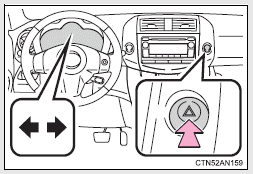
Press the switch to flash all the turn signal lights. To turn them off, press the switch once again.
NOTICE
■To prevent battery discharge
Do not leave the emergency flashers on longer than necessary when the
engine is not running.
If your vehicle needs to be towed
If towing is necessary, we recommend having your vehicle towed by your Toyota dealer or a commercial towing service, using a wheel-lift type truck or a flat bed truck. Use a safety chain system for all towing, and abide by all state/provincial and local laws. 2WD models: If towing your vehicle with a wheel-lift type truck from the front, the vehicle's rear wheels and axles must be in good conditions.
If they are damaged, use a towing dolly or flat bed truck. 4WD models: If towing your vehicle with a wheel-lift type truck, use a towing dolly.
Before towing
The following may indicate a problem with your transmission. Contact
your Toyota dealer before towing.
● The engine is running, but the vehicle will not move.
● The vehicle makes an abnormal sound.
Emergency towing
If a tow truck is not available, in an emergency your vehicle may be temporarily towed using a cable or chain secured to the emergency towing eyelet. This should only be attempted on hard surfaced roads for short distances at low speeds. A driver must be in the vehicle to steer and operate the brakes. The vehicle’s wheels, drive train, axles, steering and brakes must be in good condition.
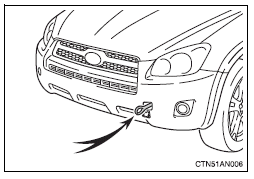
Towing eyelet
Installing towing eyelet
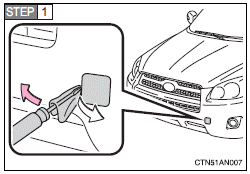
Remove the eyelet cover using a flathead screwdriver. To protect the bodywork, place a rag between the screwdriver and the vehicle body, as shown in the illustration.
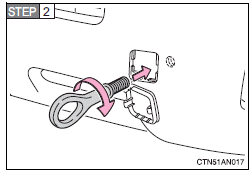
Insert the towing eyelet into the hole and tighten partially by hand.
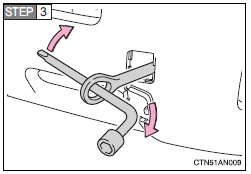
Tighten down the towing eyelet securely using a wheel nut wrench.
Towing with a sling-type truck
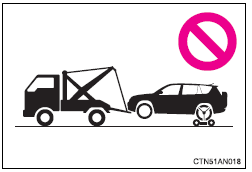
Do not tow with a sling-type truck to prevent body damage.
Towing with a wheel-lift type truck
From the front (2WD models)
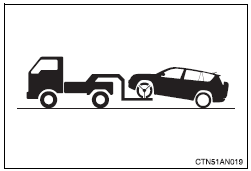
Release the parking brake.
From the front (4WD models)
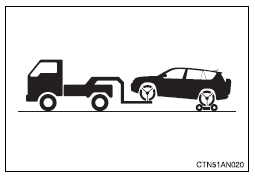
Use a towing dolly under the rear wheels.
From the rear
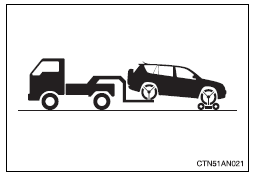
Use a towing dolly under the front wheels.
Using a flat bed truck
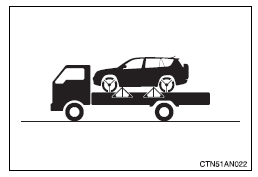
If you use chains or cables to tie down your vehicle, the angles shaded in black must be 45°. Do not overly tighten the tie downs or the vehicle may be damaged.
■Emergency towing procedure
1 Release the parking brake.
2 Shift the shift lever to N.
3 Vehicles without smart key system: Turn the engine switch to “ACC”
(engine off) or “ON” (engine running) position.
Vehicles with smart key system: Turn the “ENGINE START STOP” switch to ACCESSORY (engine off) or IGNITION ON (engine running) mode.
■Location of the emergency towing eyelet
The emergency towing eyelet is in the tool bag.
CAUTION
■Caution while towing
●Use extreme caution when towing the vehicle.
Avoid sudden starts or erratic driving maneuvers which place excessive
stress on the emergency towing eyelet and the cables or chains. Always
be cautious of the surroundings and other vehicles while towing.
●If the engine is not running, the power assist for the brakes and steering
will not function, making steering and braking more difficult.
■Installing towing eyelet to the vehicle
Make sure that towing eyelet is installed securely.
If not securely installed, towing eyelet may come loose during towing. This
may lead to accidents that cause serious injury or even death.
NOTICE
■To prevent body damage when towing with a sling-type truck
Do not tow with a sling-type truck, either from the front or rear.
■To prevent causing serious damage to the transmission and Active
Torque Control 4WD system (4WD models) when towing using a wheellift
type truck
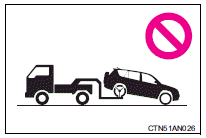
2WD models: Never tow this vehicle from the rear with the front wheels on the ground. This may cause serious damage to the transmission. If towing from the rear, use a towing dolly.
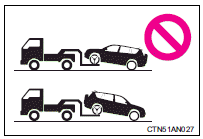
4WD models: Never tow this vehicle with any of the wheels on the ground. This may cause serious damage to the transmission and Active Torque Control 4WD system. Use a towing dolly.
■To prevent damaging the vehicle when towing using a wheel-lift type truck
When raising the vehicle, ensure adequate ground clearance for towing at the opposite end of the raised vehicle. Without adequate clearance, the vehicle could be damaged while being towed.
■Recreational towing (behind motor home, etc.)
Never dinghy tow your vehicle to prevent causing serious damage to the Active Torque Control 4WD system (4WD models) and transmission.
If you think something is wrong
If you notice any of the following symptoms, your vehicle probably needs adjustment or repair. Contact your Toyota dealer as soon as possible.
■ Visible symptoms
● Fluid leaks under the vehicle
(Water dripping from the air conditioning after use is normal.)
● Flat-looking tires or uneven tire wear
● Engine coolant temperature gauge needle continually points
higher than normal
■ Audible symptoms
● Changes in exhaust sound
● Excessive tire squeal when cornering
● Strange noises related to the suspension system
● Pinging or other noises related to the engine
■ Operational symptoms
● Engine missing, stumbling or running rough
● Appreciable loss of power
● Vehicle pulls heavily to one side when braking
● Vehicle pulls heavily to one side when driving on a level road
● Loss of brake effectiveness, spongy feeling, pedal almost
touches the floor
Fuel pump shut off system
To minimize the risk of fuel leakage when the engine stalls or an airbag inflates upon collision, the fuel pump shut off system stops supplying fuel to the engine.
Follow the procedure below to restart the engine after the system is activated.
Vehicles without smart key system
1 Turn the engine switch to the “ACC” or “LOCK” position.
2 Restart the engine.
Vehicles with smart key system
1 Turn the “ENGINE START STOP” switch OFF.
2 Restart the engine.
NOTICE
■Before starting the engine
Inspect the ground under the vehicle.
If you find that fuel has leaked onto the ground, the fuel system has been
damaged and is in need of repair. Do not restart the engine.
If a warning light turns on or a warning buzzer sounds...
Calmly perform the following actions if any of the warning lights turn on or flash. If a light turns on or flashes, but then turns off, this does not necessarily indicate a malfunction in the system.
Stop the vehicle immediately. Continuing to drive the vehicle may be dangerous.
The following warning indicates a possible problem in the brake system. Immediately stop the vehicle in a safe place and contact your Toyota dealer.

*: Parking brake engaged warning buzzer:
The buzzer sounds to indicate that the parking brake is still engaged (with the vehicle having reached a speed of 3 mph [5 km/h]).
Stop the vehicle immediately
The following warning indicates the possibility of damage to the vehicle that may lead to an accident. Immediately stop the vehicle in a safe place and contact your Toyota dealer.

Have the vehicle inspected immediately
Failing to investigate the cause of the following warnings may lead to the system operating abnormally and possibly cause an accident. Have the vehicle inspected by your Toyota dealer immediately.
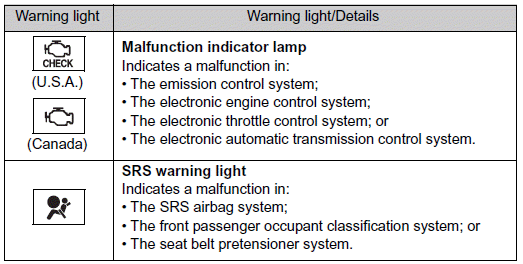
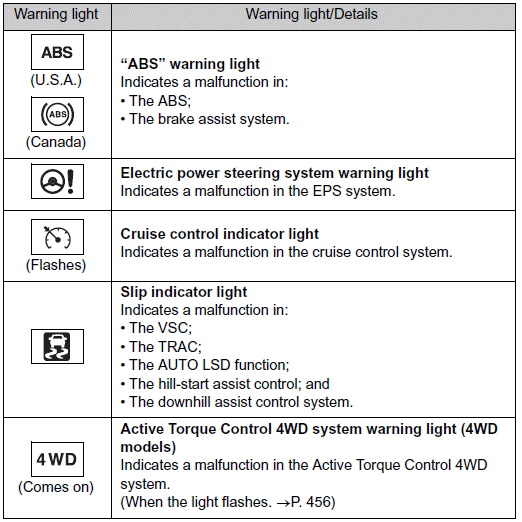
Follow the correction procedures
After taking the specified steps to correct the suspected problem, check that the warning light turns off.

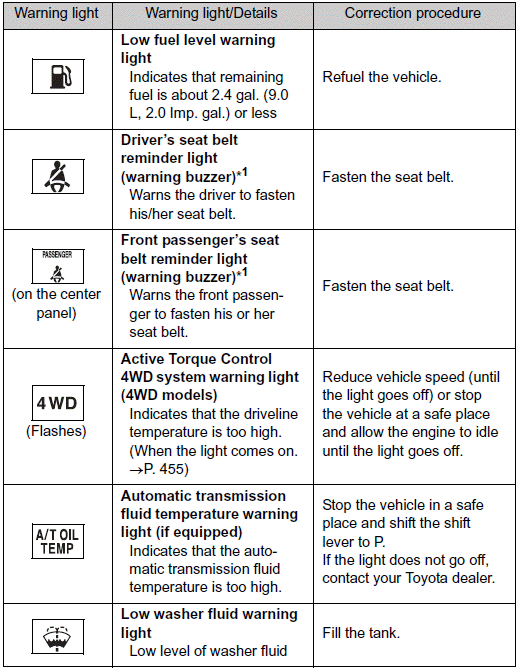
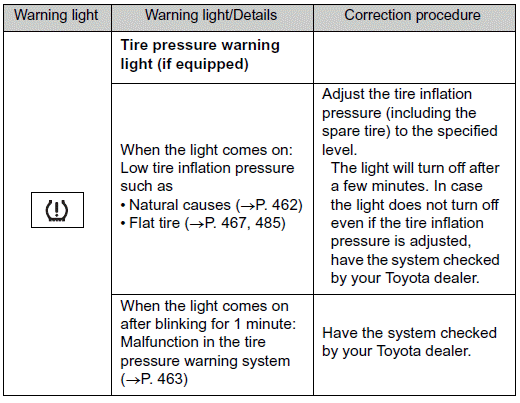
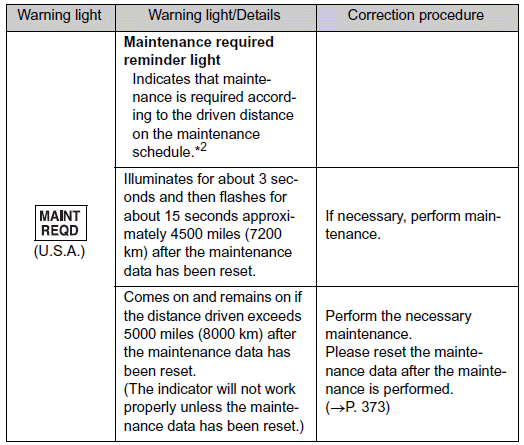
*1:Driver's and front passenger’s seat belt warning buzzers
The driver’s and front passenger’s seat belt warning buzzers sound to alert
the driver and front passenger that his or her seat belt is not fastened. The
buzzer sounds intermittently for 10 seconds after the vehicle has reached a
speed of 12 mph (20 km/h). Then, if the seat belt is still unfastened, the
buzzer will sound at a different tone for 20 more seconds.
*2:Refer to the separate “Scheduled Maintenance Guide” or “Owner's Manual
Supplement” for the maintenance interval applicable to your vehicle.
Follow the correction procedures. (vehicles with smart key system)
After taking the specified steps to correct the suspected problem, check that the warning light turns off.
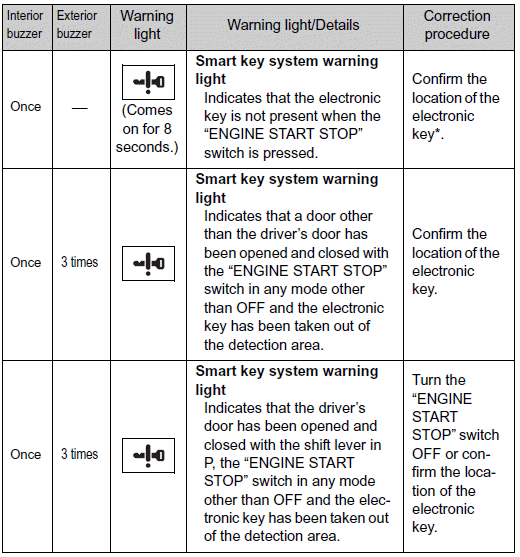
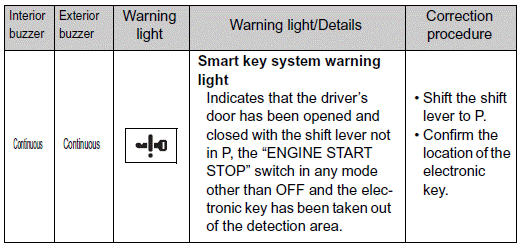
*: If the engine does not start when the electronic key is inside the vehicle, the electronic key battery may be depleted or there may be difficulties receiving the signal from the key.
■If the malfunction indicator lamp comes on while driving
First check the following:
●Is the fuel tank empty?
If it is, fill the fuel tank immediately.
●Is the fuel tank cap loose?
If it is, tighten it securely.
The malfunction indicator lamp will go off after taking several driving trips. If the malfunction indicator lamp does not go off even after several trips, contact your Toyota dealer as soon as possible.
■Front passenger detection sensor and passenger seat belt reminder
●If luggage is placed on the front passenger seat, the front passenger
detection sensor may cause the warning light to flash, even if a passenger
is not sitting in the seat.
●If a cushion is placed on the seat, the sensor may not detect a passenger,
and the warning light may not operate properly.
■Electric power steering system warning light
When the battery charge becomes insufficient or the voltage temporarily drops, the electric power steering system warning light may come on.
■The tire pressure warning light may turn on due to natural causes
The tire pressure warning light may turn on due to natural causes such as natural air leaks or tire inflation pressure changes caused by temperature. In this case, adjusting the tire inflation pressure will turn off the warning light (after a few minutes).
■When a tire is replaced with a spare tire (vehicles with a tire pressure warning system)
The spare tire is also equipped with the tire pressure warning valve and transmitter. The tire pressure warning light will turn on if the tire inflation pressure of the spare tire is low. If a tire goes flat, even though the flat tire is replaced with the spare tire, the tire pressure warning light does not turn off. Replace the spare tire with the repaired tire and adjust the proper tire inflation pressure. The tire pressure warning light will turn off after a few minutes.
■If the tire pressure warning system is inoperative
The tire pressure warning system will be disabled in the following conditions:
(When the condition becomes normal, the system will work properly.)
●If tires not equipped with tire pressure warning valves and transmitters
are used.
●If the ID code on the tire pressure warning valves and transmitters is
not registered in the tire pressure warning computer.
●If the tire inflation pressure is 73 psi (500 kPa, 5.1 kgf/cm2 or bar) or
higher.
The tire pressure warning system may be disabled in the following conditions:
(When the condition becomes normal, the system will work properly.)
●If electronic devices or facilities using similar radio wave frequencies
are nearby.
●If a radio set at similar frequencies is in use in the vehicle.
●If a window tint that affects the radio wave signals is installed.
●If there is a lot of snow or ice on the vehicle, in particular around the
wheels or wheel housings.
●If non-genuine Toyota wheels are used. (Even if you use Toyota
wheels, the tire pressure warning system may not work properly with
some types of tires.)
●If tire chains are used.
●If the spare tire is in a location subject to poor radio wave signal
reception.
●If a large metallic object which can interfere with signal reception is
put in the luggage compartment.
■If the tire pressure warning light frequently comes on after blinking for 1 minute
If the tire pressure warning light frequently comes on after blinking for 1 minute when the “ENGINE START STOP” switch or the engine switch is turned ON, have it checked by your Toyota dealer.
■Customization that can be configured at Toyota dealer
The vehicle speed linked seat belt reminder buzzer can be disabled. However, Toyota recommends that the seat belt reminder buzzer be operational to alert the driver and front passenger that the seat belts are not fastened.
CAUTION
■When the electric power steering system warning light comes on
The steering wheel may become extremely heavy.
If the steering wheel becomes heavier than usual when operating, firmly
hold and operate it using more force than usual.
■If the tire pressure warning light comes on
Be sure to observe the following precautions. Failure to do so could
cause loss of vehicle control and result in death or serious injury.
●Vehicles with run-flat tires:
• Decelerate to the lowest appropriate speed as soon as possible.
Do not drive over 55 mph (90 km/h).
• Check and adjust the tire inflation pressure immediately.
• If the tire pressure warning light comes on even after tire inflation
pressure adjustment, it is probable that you have a flat tire. Have
the tire replaced by the nearest Toyota dealer.
• Avoid abrupt maneuvering and braking. If the vehicle tires deteriorate,
you could lose control of the steering wheel or the brakes.
●Vehicles with standard tires:
• Stop your vehicle in a safe place as soon as possible. Adjust the
tire inflation pressure immediately.
• If the tire pressure warning light comes on even after tire inflation
pressure adjustment, it is probable that you have a flat tire. Check
the tires. If the tire is flat, change to the spare tire and have the flat
tire repaired by the nearest Toyota dealer.
• Avoid abrupt maneuvering and braking. If the vehicle tires deteriorate,
you could lose control of the steering wheel or the brakes.
■If a blowout or sudden air leakage should occur
The tire pressure warning system may not activate immediately.
CAUTION
■Maintenance of the tires
Each tire, including the spare (if provided), should be checked monthly
when cold and inflated to the inflation pressure recommended by the
vehicle manufacturer on the vehicle placard or tire inflation pressure
label (tire and load information label). (If your vehicle has tires of a
different
size than the size indicated on the vehicle placard or tire inflation
pressure label [tire and load information label], you should determine the
proper tire inflation pressure for those tires.)
As an added safety feature, your vehicle has been equipped with a tire pressure monitoring system (TPMS-tire pressure warning system) that illuminates a low tire pressure telltale (tire pressure warning light) when one or more of your tires is significantly under-inflated. Accordingly, when the low tire pressure telltale (tire pressure warning light) illuminates, you should stop and check your tires as soon as possible, and inflate them to the proper pressure. Driving on a significantly underinflated tire causes the tire to overheat and can lead to tire failure. Under-inflation also reduces fuel efficiency and tire tread life, and may affect the vehicle's handling and stopping ability. Please note that the TPMS (tire pressure warning system) is not a substitute for proper tire maintenance, and it is the driver's responsibility to maintain correct tire pressure, even if under-inflation has not reached the level to trigger illumination of the TPMS low tire pressure telltale (tire pressure warning light).
CAUTION
Your vehicle has also been equipped with a TPMS (tire pressure warning
system) malfunction indicator to indicate when the system is not operating
properly. The TPMS (tire pressure warning system) malfunction indicator
is combined with the low tire pressure telltale (tire pressure
warning light). When the system detects a malfunction, the telltale will
flash for approximately one minute and then remain continuously illuminated.
This sequence will continue upon subsequent vehicle start-ups as
long as the malfunction exists. When the malfunction indicator is illuminated,
the system may not be able to detect or signal low tire pressure
as intended.
TPMS (tire pressure warning system) malfunctions may occur for a variety
of reasons, including the installation of replacement or alternate tires
or wheels on the vehicle that prevent the TPMS (tire pressure warning
system) from functioning properly. Always check the TPMS (tire pressure
warning system) malfunction telltale after replacing one or more
tires or wheels on your vehicle to ensure that the replacement or alternate
tires and wheels allow the TPMS (tire pressure warning system) to
continue to function properly.
NOTICE
■Precaution when installing a different tire
When a tire of a different specification or maker is installed, the tire
pressure
warning system may not operate properly.
If you have a flat tire (vehicles with standard tires)
Remove the flat tire and replace it with the spare provided.
■ Before jacking up the vehicle
● Stop the vehicle on a hard, flat surface.
● Set the parking brake.
● Shift the shift lever to P.
● Stop the engine.
● Turn on the emergency flashers.
■ Location of the spare tire, jack and tools
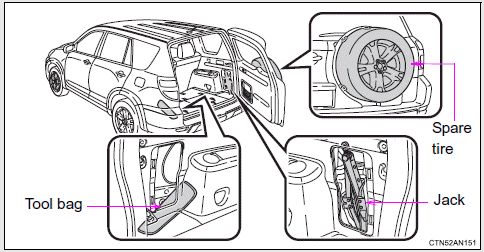
Taking out the jack
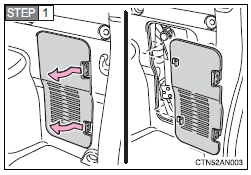
Disengage the claws and remove the cover.
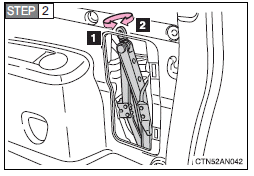
1 Loosen
2 Tighten
Loosen and take out the jack.
Taking out the tool bag
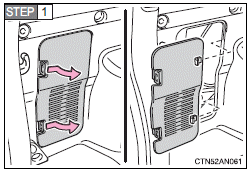
Disengage the claws and remove the cover.
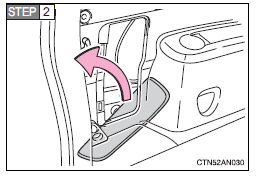
Take out the tool bag.
Taking out the spare tire (vehicles with the spare tire cover)
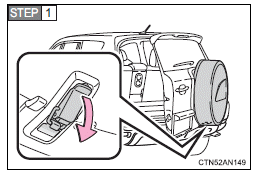
Open the back door. Unlock the latch handle which is on the bottom of the spare tire cover.
2 Close the back door.
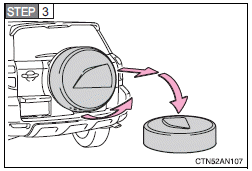
Remove the spare tire cover by holding the bottom and lifting it up and away from the vehicle. When placing the spare tire cover on the ground, make sure the cover design side faces up to avoid scratching the cover surface.
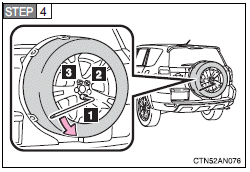
Using the wheel nut wrench, loosen the hold-down nuts by turning them counterclockwise until they can be loosened by hand. Follow the order shown in the illustration.
5 Remove all the wheel nuts and the spare tire. When placing the spare tire on the ground, make sure the wheel design side faces up to avoid scratching the wheel surface.
Taking out the spare tire (vehicles without the spare tire cover)
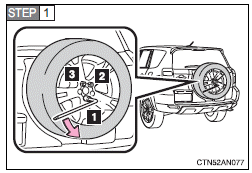
Using the wheel nut wrench, loosen the hold-down nuts by turning them counterclockwise until they can be loosened by hand. Follow the order shown in the illustration.
2 Remove all the wheel nuts and the spare tire. When placing the spare tire on the ground, make sure the wheel design side faces up to avoid scratching the wheel surface.
Replacing a flat tire
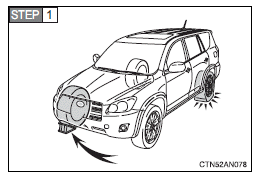
Chock the tires.
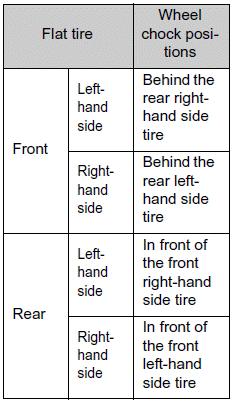
2 Remove the wheel ornament using the wheel nut wrench as shown below.
16-inch wheel
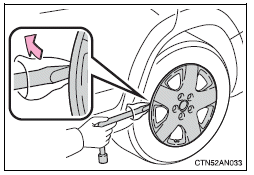
To protect the wheel ornament, place a rag between the wrench and the wheel ornament, as shown in the illustration.
17-inch and 18-inch wheels
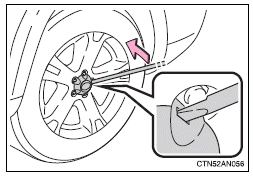
Slightly loosen the wheel nuts (one turn).
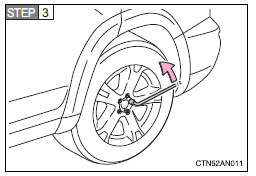
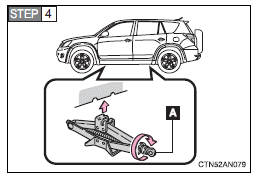
Turn the tire jack portion “A” by hand until the notch of the jack is in contact with the jack point.
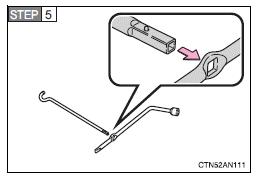
Type A: Assemble the jack handle extension.
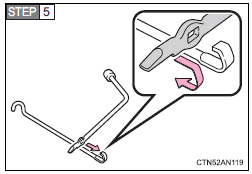
Type B: Assemble the jack handle extension.
6 Raise the vehicle until the tire is slightly raised off the ground.
Type A
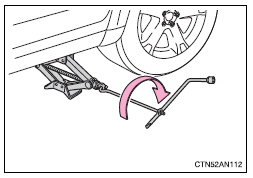
Type B
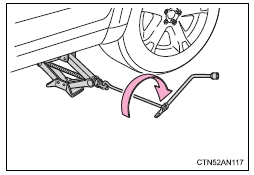
Type C
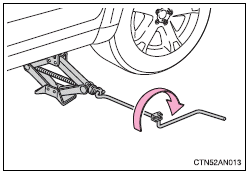
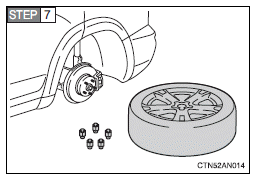
Remove all the wheel nuts and the tire. When resting the tire on the ground, place the tire so that the wheel design faces up to avoid scratching the wheel surface.
Installing the tire
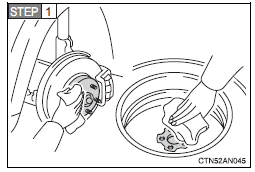
Remove any dirt or foreign matter from the wheel contact surface. If foreign matter is on the wheel contact surface, the wheel nuts may loosen while the vehicle is in motion, and the tire may come off the vehicle.
2 Install the tire and loosely tighten each wheel nut by hand by approximately the same amount.
Replacing a steel wheel with a steel wheel
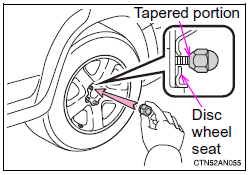
Tighten the nuts until the tapered portion comes into loose contact with the disc wheel seat.
Replacing an aluminum wheel with a steel wheel
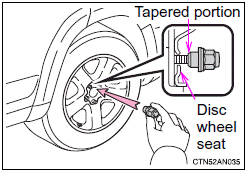
Tighten the nuts until the tapered portion comes into loose contact with the disc wheel seat.
Replacing an aluminum wheel with an aluminum wheel
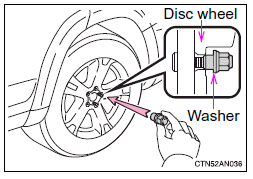
Turn the nut washers until they come into contact with the disc wheel.
3 Lower the vehicle.
Type A
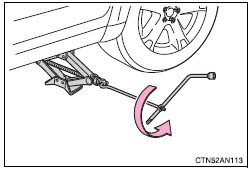
Type B
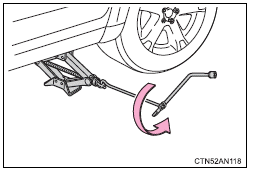
Type C
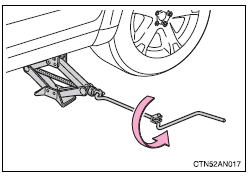
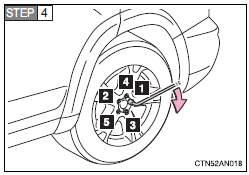
Firmly tighten each nut two or
three times in the order shown in
the illustration.
Tightening torque:
76 ft•lbf (103 N•m, 10.5 kgf•m)
5 Reinstall the wheel ornament.
16-inch wheel
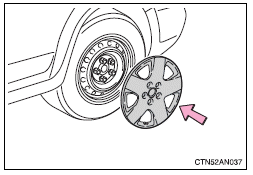
17-inch and 18-inch wheels
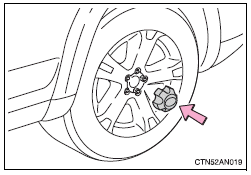
Stowing the flat tire
1 Remove any dirt or foreign matter from the disc wheel seat and the wheel contact surface.
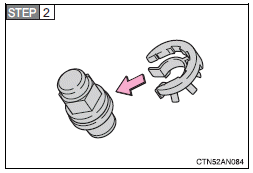
Vehicles with aluminum wheels and a steel wheel for the spare:
Remove the plastic rings from the wheel nuts of the spare tire carrier.
3 Close the back door.
4 Stow the flat tire on the back door and tighten all wheel nuts
by hand.
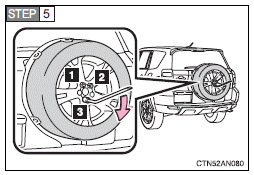
Using the wheel nut wrench, tighten the hold-down nuts by turning them clockwise. Follow the order shown in the illustration.
Tightening torque:
66.4 ft•lbf (90 N•m, 9.1 kgf•m)
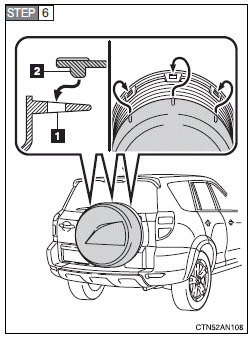
Insert the hooks into the upper slots and lower the cover to install the spare tire cover.
1 Upper slots
2 Hooks
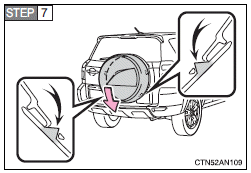
Attach the cover by hooking the 2 inner protrusions. Check that the cover is securely attached.
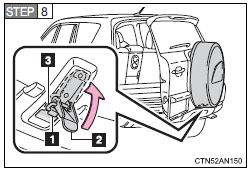
Open the back door and lock the latch handle which is on the bottom of the cover.
1 Hook
2 Latch handle
3 Clasp
9 Close the back door.
10 Stow the jack and all tools securely, and replace all the covers.
■When reinstalling the wheel ornament (vehicles with 16-inch wheels)
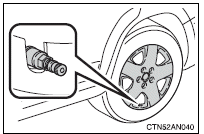
Align the cutout of the wheel ornament with the valve stem as shown.
■After completing the tire change (vehicles with a tire pressure warning system)
The tire pressure warning system must be reset.
■After repairing the flat tire (vehicles with aluminum wheels and a steel wheel for the spare)
Be sure to reinstall the plastic rings to the wheel nuts before stowing the spare tire. If the steel wheel is stowed without reinstalling the plastic rings to the wheel nuts, the spare tire carrier may produce abnormal noise when the vehicle is moving.
CAUTION
■Using the tire jack
Improper use of the tire jack may lead to death or serious injuries due to
the vehicle suddenly falling off the jack.
●Do not use the tire jack for any purpose other than replacing tires or
installing and removing tire chains.
●Only use the tire jack that comes with this vehicle for replacing a flat
tire.
Do not use it on other vehicles, and do not use other tire jacks for
replacing tires on this vehicle.
●Always check that the tire jack is securely set to the jack point.
●Do not put any part of your body under the vehicle while it is supported
by the jack.
●Do not start or run the engine while your vehicle is supported by the
jack.
●Do not raise the vehicle while someone is in it.
●When raising the vehicle, do not put an object on or under the jack.
●Do not raise the vehicle to a height greater than that required to
replace the tire.
●Use a jack stand if it is necessary to get under the vehicle.
●Stop the vehicle on firm, flat and level ground, firmly set the parking
brake and shift the shift lever to P. Block the wheel diagonally opposite
to the one being changed if necessary.
Take particular care when lowering the vehicle to ensure that no one
working on or near the vehicle will be injured.
■Using the jack handle (type A)
Insert the square head securely until you hear a click to prevent the
extension parts from coming apart unexpectedly.
CAUTION
■Replacing a flat tire
●Observe the following precautions.
Failure to do so may result in serious injury.
• Do not try to remove the ornament by hand. Take due care in handling
the ornament to avoid unexpected personal injury.
• Do not attach a heavily damaged wheel ornament, as it may fly off
the wheel while the vehicle is moving.
●Failure to follow these precautions could cause the wheel nuts to
loosen and the tire to fall off, resulting in death or serious injury.
• Have the wheel nuts tightened with a torque wrench to 76 ft•lbf (103
N•m, 10.5 kgf•m) as soon as possible after changing wheels.
• Make sure that the rubber rings are not installed to the wheel nuts
for aluminum wheel.
• When installing the wheel nuts, be sure to install them with the
tapered ends facing inward.
NOTICE
■Do not drive the vehicle with a flat tire
Do not continue driving with a flat tire.
Driving even a short distance with a flat tire can damage the tire and the
wheel beyond repair.
■When replacing the tires (vehicles with a tire pressure warning system)
When removing or fitting the wheels, tires or the tire pressure warning
valve and transmitter, contact your Toyota dealer as the tire pressure
warning valve and transmitter may be damaged if not handled correctly.
■To avoid damage to the tire pressure warning valves and transmitters
(vehicles with a tire pressure warning system)
When a tire is repaired with liquid sealants, the tire pressure warning
valve and transmitter may not operate properly. If a liquid sealant is
used, contact your Toyota dealer or other qualified service shop as soon
as possible. Make sure to replace the tire pressure warning valve and
transmitter when replacing the tire.
If you have a flat tire (vehicles with run-flat tires)
Take your vehicle to the nearest Toyota dealer or authorized tire dealer as soon as possible.
■ Run-flat tires (A “RFT” or “DSST” mark is molded on the sidewall)
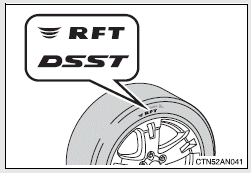
You can continue driving a vehicle with run-flat tires even if any tire goes flat. It is possible to run for a maximum of 100 miles (160 km) at a speed below 55 mph (90 km/h) after the tire pressure warning light comes on.
■In some condition (such as at high temperatures)
You cannot continue driving for up to 100 miles (160 km).
■If you cannot distinguish between the standard tires and run-flat tires
Consult your Toyota dealer.
■For the detailed information on run-flat tires
See the tire warranty book.
NOTICE
■When replacing the tires
When removing or fitting the wheels, tires or the tire pressure warning
valve and transmitter, contact your Toyota dealer as the tire pressure
warning valve and transmitter may be damaged if not handled correctly.
■To avoid damaging the tire pressure warning valves and transmitters
Do not use liquid sealants on flat tires.
If the engine will not start
If the engine will not start even though correct starting procedures are being followed or releasing the steering lock, consider each of the following points.
■ The engine will not start even when the starter motor operates normally.
One of the following may be the cause of the problem.
● There may not be sufficient fuel in the vehicle’s tank.
Refuel the vehicle.
● The engine may be flooded.
Try to restart the engine once more following correct starting
procedures.
● There may be a malfunction in the engine immobilizer system.
■ The starter motor turns over slowly, the interior lights and headlights are dim, or the horn does not sound or sounds at a low volume.
One of the following may be the cause of the problem.
● The battery may be discharged.
● The battery terminal connections may be loose or corroded.
■ The starter motor does not turn over, the interior lights and headlights do not turn on, or the horn does not sound.
One of the following may be the cause of the problem.
● One or both of the battery terminals may be disconnected.
● The battery may be discharged.
● There may be a malfunction in the steering lock system (vehicles
with smart key system).
Contact your Toyota dealer if the problem cannot be repaired, or if repair procedures are unknown.
If the shift lever cannot be shifted from P
If the shift lever cannot be shifted with your foot on the brake, there may be a problem with the shift lock system (a system to prevent accidental operation of the shift lever). Have the vehicle inspected by your Toyota dealer. The following steps may be used as an emergency measure to ensure that the shift lever can be shifted.
1 Set the parking brake.
2 Vehicles without smart key system: Turn the engine switch
to the “LOCK” position.
Vehicles with smart key system: Turn the “ENGINE START
STOP” switch off.
3 Depress the brake pedal.
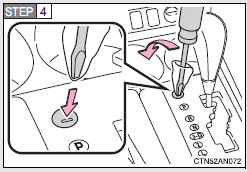
Pry the cover up with a flathead screwdriver or equivalent.
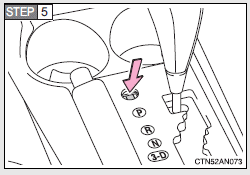
Press the shift lock override button. The shift lever can be shifted while the button is pressed.
If you lose your keys
New genuine keys can be made by your Toyota dealer. For vehicles with the smart key system, bring the other key and the key number stamped on the key number plate. For vehicles without the smart key system, bring a master key and the key number stamped on the key number plate.
If the electronic key does not operate properly (vehicles with smart key system)
If communication between the electronic key and the vehicle is interrupted or the electronic key cannot be used because the battery is depleted, the smart key system and wireless remote control cannot be used. In such cases, the doors and back door can be opened and the engine can be started by following the procedure below.
Locking and unlocking the doors with the mechanical key
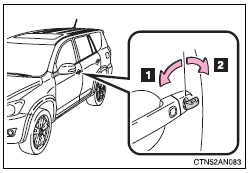
Using the mechanical key in order to perform the following operations:
1 Locks all doors
2 Unlocks all doors
Turning the key unlock the driver’s door. Turning the key once again unlocks the other doors.
Starting the engine
1 Shift the shift lever to P and apply the brakes.
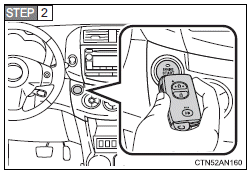
Touch the Toyota emblem side of the electronic key to the “ENGINE START STOP” switch. If any of the doors is opened and closed while the key is being touched to the switch, an alarm will sound to indicate that the start function cannot detect the electronic key.
3 Press the “ENGINE START STOP” switch within 5 seconds after the buzzer sounds, keeping the brake pedal depressed.
In the event that the “ENGINE START STOP” switch still cannot be operated, contact your Toyota dealer.
■Stopping the engine
Shift the shift lever to P and press the “ENGINE START STOP” switch as you normally do when stopping the engine.
■Replacing the key battery
As the above procedure is a temporary measure, it is recommended that the electronic key battery be replaced immediately when the battery is depleted.
■Changing “ENGINE START STOP” switch modes
Within 5 seconds of the buzzer sounding, release the brake pedal and press the “ENGINE START STOP” switch. The engine does not start and modes will be changed each time the switch is pressed.
If the battery is discharged
The following procedures may be used to start the engine if the vehicle's battery is discharged. You can call your Toyota dealer or qualified repair shop. If you have a set of jumper (or booster) cables and a second vehicle with a 12-volt battery, you can jump start your Toyota following the steps below.

Connecting the jumper cables
1 Positive (+) battery terminal on your vehicle
2 Positive (+) battery terminal on the second vehicle
3 Negative (-) battery terminal on the second vehicle
4 Connect the jumper cable to ground on your vehicle as shown in
the illustration.
2 Start the engine of the second vehicle. Increase the engine speed slightly and maintain at that level for approximately 5 minutes to recharge the battery of your vehicle.
3 Vehicles with smart key system — Open and close any of the doors with the “ENGINE START STOP” switch OFF.
4 Maintain the engine speed of the second vehicle, and turn the engine switch to the “ON” position (vehicles without smart key system) or turn the “ENGINE START STOP” switch to IGNITION ON mode (vehicles with smart key system), to start the vehicle's engine.
5 Once the vehicle’s engine has started, remove the jumper cables in the exact reverse order in which they were connected.
Once the engine starts, have the vehicle checked at your Toyota dealer as soon as possible.
■Starting the engine when the battery is discharged
The engine cannot be started by push-starting.
■To prevent battery discharge
●Turn off the headlights and the audio system while the engine is turned
off.
●Turn off any unnecessary electrical components when the vehicle is running
at a low speed for an extended period, such as in heavy traffic, etc.
■Charging the battery
The electricity stored in the battery will discharge gradually even when the vehicle is not in use, due to natural discharge and the draining effects of certain electrical appliances. If the vehicle is left for a long time, the battery may discharge, and the engine may be unable to start. (The battery recharges automatically during driving.)
CAUTION
■Avoiding battery fires or explosions
Observe the following precautions to prevent accidentally igniting the flammable
gas that may be emitted from the battery.
●Make sure the jumper cable is connected to the correct terminal and that it
is not unintentionally in contact with any part other than the intended
terminal.
●Do not allow the jumper cables to come into contact with the “+” and “-”
terminals.
●Do not smoke, use matches, cigarette lighters or allow open flame near
the battery.
■Battery precautions
The battery contains poisonous and corrosive acidic electrolyte, while
related parts contain lead and lead compounds. Observe the following precautions
when handling the battery.
●When working with the battery, always wear safety glasses and take care
not to allow any battery fluids (acid) to come into contact with skin, clothing
or the vehicle body.
●Do not lean over the battery.
●In the event that battery fluid comes into contact with the skin or eyes,
immediately wash the affected area with water and seek medical attention.
Place a wet sponge or cloth over the affected area until medical attention
can be received.
●Always wash your hands after handling the battery support, terminals, and
other battery-related parts.
●Do not allow children near the battery.
NOTICE
■When handling jumper cables
Be careful that the jumper cables do not become tangled in the cooling fans
or any of the belts when connecting or disconnecting them.
If your vehicle overheats
If your engine overheats:
1 Stop the vehicle in a safe place and turn off the air conditioning system.
2 Check to see if steam is coming out from under the hood.
If you see steam:
Stop the engine. Carefully lift the hood after the steam subsides
and then restart the engine.
If you do not see steam:
Leave the engine running and carefully lift the hood.
3 Check to see if the cooling fans are operating.
If the fans are operating:
Wait until the temperature of the engine (shown on the
instrument cluster) begins to fall and then stop the engine.
If the fans are not operating:
Stop the engine and call your Toyota dealer.

After the engine has cooled down sufficiently, check the engine coolant level and inspect the radiator core (radiator) for any leaks. If the engine compartment cover needs to be removed.

Add engine coolant if necessary. Water can be used in an emergency if engine coolant is unavailable.
Have the vehicle checked at the nearest Toyota dealer as soon as possible.
■Overheating
If you observe the following, your vehicle may be overheating.
●The engine coolant temperature gauge enters the red zone or a loss of
power is experienced.
●Steam is coming from under the hood.
CAUTION
■To prevent an accident or injury when inspecting under the hood of
your vehicle
●If steam is seen coming from under the hood, do not open the hood until
the steam has subsided. The engine compartment may be very hot, causing
serious injury such as burns.
●Keep hands and clothing away from the fan and other belts while the
engine is running.
●Do not loosen the coolant reservoir cap while the engine and radiator are
hot.
Serious injury, such as burns, may result from hot coolant and steam
released under pressure.
NOTICE
■When adding engine coolant
Wait until the engine has cooled down before adding engine coolant.
When adding coolant, do so slowly. Adding cool coolant to a hot engine too
quickly can cause damage to the engine.
If the vehicle becomes stuck
Carry out the following procedures if the tires spin or the vehicle becomes stuck in mud, dirt, or snow.
1 Stop the engine. Set the parking brake and put the shift lever in P.
2 Remove the mud, snow, or sand from around the stuck tire.
3 Place wood, stones or some other material to help provide traction under the tires.
4 Restart the engine
5 4WD models: Activate four-wheel drive lock mode.
6 Shift the shift lever to the D or R position, release the parking brake and carefully depress the accelerator pedal to free the vehicle.
Turn off TRAC and/or VSC if these functions are hampering your attempts to free the vehicle.
CAUTION
■When attempting to free a stuck vehicle
If you choose to rock the vehicle back and forth to free it, make sure the
surrounding
area is clear, to avoid striking other vehicles, objects or persons.
The vehicle may also lunge forward or lunge back suddenly as it becomes
free. Use extreme caution.
■When shifting the shift lever
Be careful not to shift the shift lever with the accelerator pedal depressed.
This may lead to unexpected rapid acceleration of the vehicle that may
cause an accident and result in death or serious injury.
NOTICE
■To avoid damaging the transmission and other components
●Avoid spinning the wheels and do not rev the engine.
●If the vehicle remains stuck after trying these procedures, the vehicle may
require towing to be freed.
If your vehicle has to be stopped in an emergency
Only in an emergency, such as if it becomes impossible to stop the vehicle in the normal way, stop the vehicle using the following procedure:
1 Steadily step on the brake pedal with both feet and firmly
depress it.
Do not pump the brake pedal repeatedly as this will increase the
effort required to slow the vehicle.
2 Shift the shift lever to N.
If the shift lever is shifted to N
3 After slowing down, stop the vehicle in a safe place by the road.
4 Stop the engine.
If the shift lever cannot be shifted to N
3 Keep depressing the brake pedal with both feet to reduce vehicle speed as much as possible.

Vehicles without a smart key system: Stop the engine by turning the engine switch to the “ACC” position.

Vehicles with a smart key system:
Stop the engine by pressing and holding the “ENGINE START STOP” switch for 3 consecutive seconds or more.
5 Stop the vehicle in a safe place by the road.
CAUTION
■If the engine has to be turned off while driving
●Power assist for the brakes and steering wheel will be lost, making the
brake pedal harder to depress and the steering wheel heavier to turn.
Decelerate as much as possible before turning off the engine.
●Vehicles without a smart key system: Never attempt to remove the key, as
doing so will lock the steering wheel.
See also:
Automatic transmission
CAUTION:
Damage to the transmission may occur if the following
precautions are not observed:
• Shift into PARK only after the vehicle has come to
a complete stop.
• Shift into or out of REVERSE only after the
vehicle has come to a com ...
Using four-wheel drive
Driving on snow- or Ice-covered roads (“4WD LOCK” for full-time 4WD operation)
• Use snow tires. See “Tires” in this section for more information. • Keep an adequate
distance between yourself and other vehicles. • Avoid sudden braki ...

 Do-it-yourself maintenance
Do-it-yourself maintenance